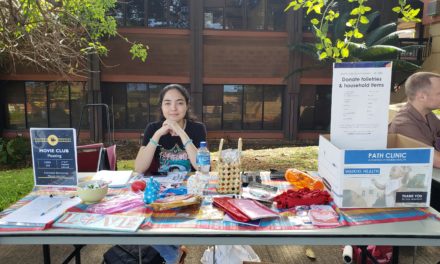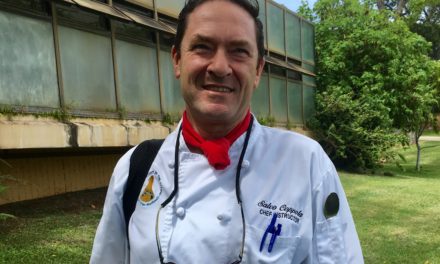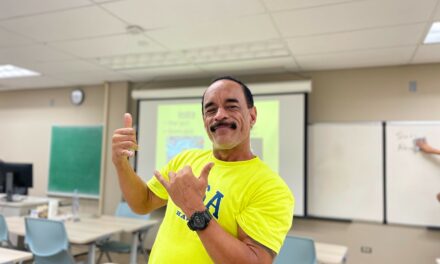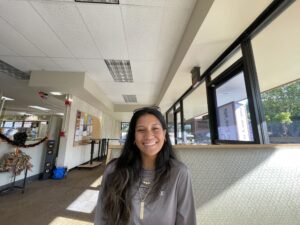CIP has yet to have a butchery program. With instructor Bryan Mayer students will not only learn the art of butchery but also how to connect with their local food community. (Photo courtesy of Bryan Mayer)
By Sarah Burchard | Staff Writer
Correction: An earlier version of this story stated the butchery training program at Fleisher’s began in 2004. While the butcher shop opened in 2004, the training program was not established until 2010, according to Bryan Mayer.
I joined Bryan Mayer on a Friday afternoon last month to talk about meat. In 2010, Mayer co-developed the Fleisher’s Craft Butchery training program in New York, pushing the craft butchery movement of the early 2000s further into the mainstream.
At 52, two decades after his career as a butcher took off, Mayer is ready to bring his expertise to the Culinary Institute of the Pacific (CIP). Half way through his current 89-day contract as an education specialist, Mayer has already proven to be an asset to the department. His expertise contributes to Roy Yamaguchi’s vision of making CIP a world class culinary institution, and he fosters a connection to Hawaiʻi’s agricultural industry that wasn’t there before.
“Bryan’s been a very integral part of the team,” said Grant Itomitsu, KCC’s Culinary department chair. “We probably didn’t know how integral he was until he started jumping in to help with the program.”
Itomitsu said KCC did get approved by the legislature to create a new full-time position at CIP, but that it is still in the process of deciding who will be the best fit for the team.
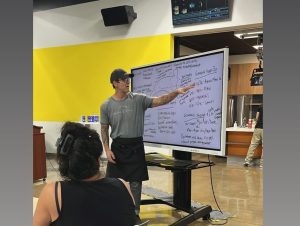
For butchery courses, Bryan Mayer teaches students about animal farming, processing and slaughter and gives hands-on butchery demonstrations. (Photo courtesy of Bryan Mayer)
Who is Bryan Mayer?
Mayer has had a plethora of experiences that have built upon each other to form who he is today: a skilled butcher and educator. He’s been a line cook, worked in artisanal food retail, run butcher counters and wrote for Food Republic. He’s gutted and filleted thousands of fish on the dock of Sheep’s Head Bay in New York, scored an apprenticeship with Joshua Applestone – founder of Fleisher’s Grass-Fed and Organic Meats (2004-2013), which led a national movement in whole animal butchery – and helped Applestone teach butchery when Fleisher’s began offering classes at the flagship shop in Kingston, New York in 2010.
By that time, Fleisher’s was serving the likes of Anthony Bourdain and Michael Pollen. Applestone and Mayer were doing butchery demos with Martha Stewart and Fleisher’s butchers were rising to fame.
In 2012, Mayer said he had a vision of folding Fleisher’s butchery school into the Culinary Institute of America’s culinary programming, which was one town over from Fleisher’s in Hyde Park. He continued to advocate for the partnership and tried to revive the school over the following five years (even after Fleisher’s changed ownership), but in 2017 the school closed completely.
In 2018, after dabbling in consultation, media performances and running a restaurant, Kunoa Cattle Company on Oʻahu asked Mayer to join its management team. Mayer had never visited Hawaiʻi and was unaware of its cattle industry. He enjoyed working with its original CEO Jack Beuttell, but a year later the company was sold to Hawaiʻi Meats. Mayer stayed on one more year until the pandemic hit and the company eliminated his position.
Mayer went on to work for Maui Nui Venison, working as the company’s sole butcher in their mobile-slaughterhouse facility and helping Maui Nui Venison to grow and create the infrastructure to be able to process more venison on island, so they wouldn’t have to freeze it and send it to the continent to be processed. This not only cut down on fossil fuels and created jobs, it also improved the integrity of the product.
Mayer said he trained all the new butchers and the hunters, who already knew how to break down an animal in the field but had never learned butchery under USDA guidelines for retail.
“The local folks that I meet here are some of the most talented, industrious folks that I’ve ever come across,” Mayer said. “They can make anything from anything.”
Creating the butchery program at Maui Nui Venison showed Mayer proof of concept. That a sustainable business model like theirs could be done. It also brought him farther into the fold of Hawaiʻi’s agricultural community.
Faun Skyles, the culinary director for Farm Link Hawaiʻi, invited Mayer to do a stint at Farm Link when its butcher left.
“Bryan brought both deep knowledge and genuine passion for the craft, generously sharing his expertise with our newly trained butchers,” Skyles said. “His experience was a valuable gift to the entire team.”

Students learn the anatomy of animals and how the land affects food production. (Photo courtesy of Bryan Mayer)
Mayer comes to CIP
Mayer’s desire to teach remains steadfast. Last year, he taught two butchery courses at CIP – hog and venison – and is now currently assisting Itomitsu and the rest of the team. Itomitsu said CIP intends to develop a comprehensive meat program and enhance local chef’s confidence in working with non-traditional meats (think sheep and goat).
“One of the areas that nobody has here is any kind of training or certification,” Itomitsu said. “There really isn’t a whole lot of certification or training facilities that people can come to. And so, you know, perfect, we’re a culinary program and now we have somebody who’s an expert in that area and has connections with more people in that area. How do we create a program that will be utilized to help support the state, or to help support feeding the state especially?”
Mayer brings a wealth of butchery knowledge and gets students thinking beyond culinary school norms. For example, he encourages students to look beyond what he calls “the big three” – beef, pork and chicken – and wants them to get excited about the prospect of working with non-traditional meats.
“I want to help them have that power,” he said. “Continuing education is huge. Education, not just about livestock and meat, but, like, its importance in the larger food community. Not just from a nutrition standpoint, but from an environmental standpoint.”
Last month, Mayer brought CIP students on a farm kill with the agricultural students from GoFarm. During the outing, they talked about the importance of sheep and goats in terms of managing invasive flora, since these animals can eat certain toxic plants, and access precarious terrain that cattle can’t. On a farm, students can get an understanding of the full agricultural system behind meat production as well as learn how their surrounding environment works. As an advocate for prioritizing local sourcing, Mayer also acknowledges its limitations, believing instead of the “trinity” of farmer, chef, and consumer working together.
Mayer is excited to be at CIP and hopes for a full-time conversion after his 89 days are up. Not only has he wanted to teach at CIP for the past two years, he is also now finally getting to work with educators from the CIA – his dream from his Fleisher’s days – who are here collaborating with CIP in its workforce program. Mayer laughed when he thought about this full-circle moment.
“I’ve traveled 5,000 miles to be working with the CIA,” he said. “It’s crazy.”


